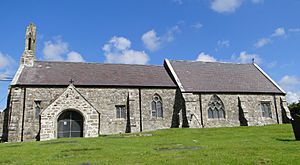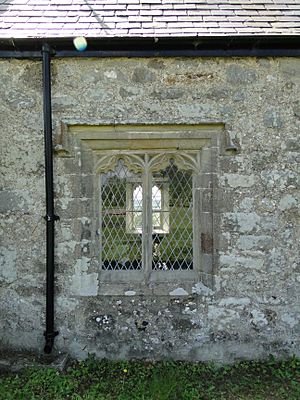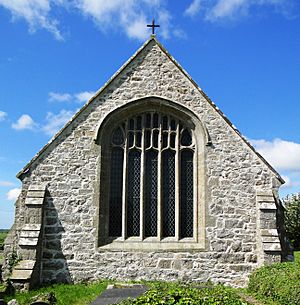St Cristiolus's Church, Llangristiolus facts for kids
Quick facts for kids St Cristiolus's Church, Llangristiolus |
|
|---|---|

|
|
| Lua error in Module:Location_map at line 420: attempt to index field 'wikibase' (a nil value). | |
| OS grid reference | SH 450 736 |
| Location | Llangristiolus, Anglesey |
| Country | Wales, United Kingdom |
| Denomination | Church in Wales |
| Website | St Cristiolus's Church |
| History | |
| Status | Church |
| Founded | 610 (reputedly) Present building dates from 12th century |
| Founder(s) | St Cristiolus (reputedly) |
| Dedication | St Cristiolus |
| Architecture | |
| Functional status | Active |
| Heritage designation | Grade II* |
| Designated | 30 January 1968 |
| Architect(s) | Henry Kennedy (1852 restoration) |
| Style | Mainly in Decorated style |
| Specifications | |
| Length | Nave 44 ft 9 in (13.6 m); chancel 32 ft 9 in (10.0 m) |
| Width | Nave 15 ft 6 in (4.7 m); chancel 20 ft 6 in (6.2 m) |
| Materials | Rubble masonry, dressed with freestone |
| Administration | |
| Parish | Plwyf Seintiau Braint a Chefni |
| Deanery | Malltraeth |
| Archdeaconry | Bangor |
| Diocese | Diocese of Bangor |
| Province | Province of Wales |
St Cristiolus's Church in Llangristiolus, Anglesey, is a very old church in north Wales. The village gets its name from the church. People believe that St Cristiolus started a church here way back in 610 AD. The building you see today was mostly built in the 1100s and 1200s.
Over the years, the church has been changed and updated. For example, a very large window was added in the 1500s. Some parts were also rebuilt in the mid-1800s. Today, St Cristiolus's Church is still used for services every Sunday. It is part of the Church in Wales. The church is also a special "Grade II* listed building." This means it's a very important historical building. It's protected because it's so old and has unique features like its large east window. Inside, you can see a decorated font from the 1100s. There are also memorials from the 1700s, 1800s, and 1900s. The churchyard is the burial place of Richard Owen, a famous preacher from the 1800s. It also holds the graves of Edward and Annie Greenly, who were important geologists.
History of the Church
St Cristiolus's Church is located in the middle of Anglesey, north Wales. It sits on high ground near the A5 and A55 roads. The village of Llangristiolus is about 1 kilometre (0.6 miles) west of the church. The name "Llangristiolus" comes from the Welsh word llan, which means "church" or "enclosure," combined with the saint's name, Cristiolus.
No one knows exactly when the first church was built here. However, it is thought that St Cristiolus founded a church on this spot in 610 AD. St Cristiolus was a saint from the 600s. He was a follower of St Cadfan, another saint linked to a Christian community on Bardsey Island in Wales. St Cristiolus is also believed to have founded churches in other parts of Wales.
The church building we see today dates back to the 1100s. It is the only medieval building in the area. In the 1200s, the chancel (the part of the church where the altar is) was made longer. The older part of the church might have been rebuilt using the original stones around this time. More changes were made in the early 1500s, when some windows were added to the chancel. In 1852, the nave (the main part of the church) and chancel were restored. This work was done by Henry Kennedy, an architect for the Diocese of Bangor. During this restoration, the chancel was rebuilt, and more windows were added.
St Cristiolus's Church is still actively used for worship. It is part of the Church in Wales. It is one of six churches in a group called the Plwyf Seintiau Braint a Chefni. Services are held every Sunday morning. They switch between a service of Holy Communion and Morning Prayer. These services are held in both Welsh and English.
Many people have been connected to the church over the centuries. These include Henry Maurice, a professor at the University of Oxford in the 1600s. His father was a priest at the church. Also, Owen Wynne Jones, a writer and priest from the 1800s, worked here for a while. The famous preacher Richard Owen was born in this area and is buried in the churchyard.
Church Design and Features
The church is built from rough stones called rubble masonry. It is decorated with smoother, cut stones called freestone. The main part of the church, the nave, is about 13.6 metres (44 feet 9 inches) long and 4.7 metres (15 feet 6 inches) wide. The chancel, at the east end, is about 10 metres (32 feet 9 inches) long and 6.25 metres (20 feet 6 inches) wide. The chancel is a bit wider than the nave. Both parts of the church have outside supports called buttresses.
Inside, the arch that separates the nave from the chancel was built in the 1200s. It is about 3.7 metres (12 feet) wide and 5.8 metres (19 feet) tall. The church has windows from the early 1500s in the chancel. The large east window is in a style called Perpendicular style. This is different from the rest of the church, which is mostly in the Decorated style. This window is very big, about 3.3 metres (10 feet 10 inches) wide and 4.3 metres (14 feet 2 inches) tall. It has five sections of coloured glass. A smaller window in the north wall also dates from the 1500s. A matching window was added on the opposite wall in the 1800s. Other windows in the church are from the 1800s. One window in the nave has stained glass. It is a memorial to two local people who passed away in the 1990s.
You enter the church through a porch on the south side. This porch was probably built in the 1500s. On the roof, which is made of slate, there is a fancy bell tower for one bell. This was added by Henry Kennedy. Inside, you can see the wooden beams and supports of the roof. The wooden benches (pews) and choir stalls were added in the 1800s. There are also brass memorials inside the church. One is for William Morgan, who died in 1713. Another memorial remembers those from the area who died in the First World War.
The round font, used for baptisms, is made of gritstone. It is located at the west end of the church and dates from the 1100s. It has six decorated panels. The patterns on this font are similar to those found on other fonts in north-west Wales. These patterns show links to Irish and Norse art styles from the Middle Ages.
Churchyard
The churchyard is the burial ground around the church. It contains six graves from the Commonwealth War Graves Commission. These are for soldiers and an airman who died during World War I and World War II.
Why the Church is Important
The church is recognized nationally as a "Grade II* listed building". This is the second-highest level of protection for buildings in the UK. It means the church is a "particularly important building of more than special interest." It received this status on January 30, 1968. It is listed because it is a medieval church that mostly dates from the 1100s and 1200s, which is unusual for Anglesey. Cadw, the Welsh government body that protects historical buildings, also notes the "fine 16th-century rebuilding of the chancel" and its special window. The arch inside the church has been called the best of its kind in the region. The large east window has been described as "almost too big to fit" in the wall.
In the 1800s, a historian named Angharad Llwyd said the church was "a spacious structure" with "excellent architectural details." She also noted its "east window, of good design." Another historian, Harry Longueville Jones, wrote in 1846 that the chancel arch showed "workmanship of good character."
Sir Stephen Glynne, a Welsh politician and church historian, visited the church in 1849. He thought it was a "fair specimen of the better sort of Anglesey village church." He also said the chancel arch was "of considerable elegance, unusual in North Wales."



